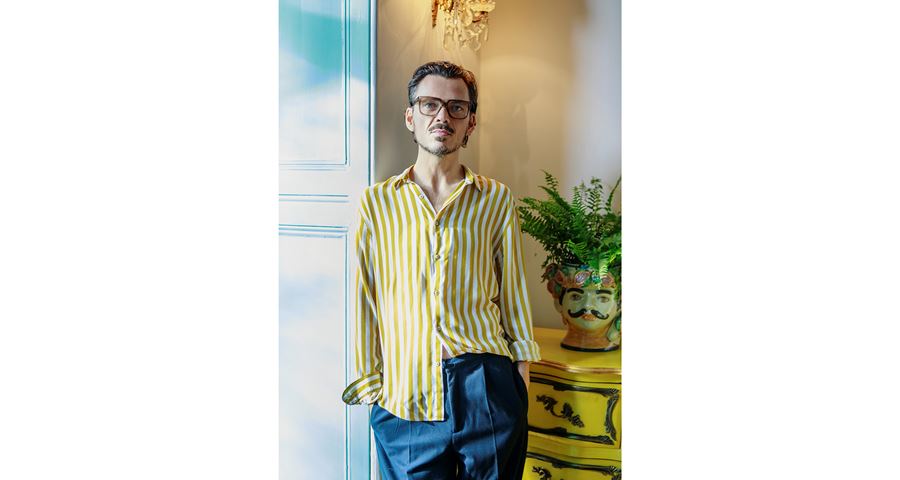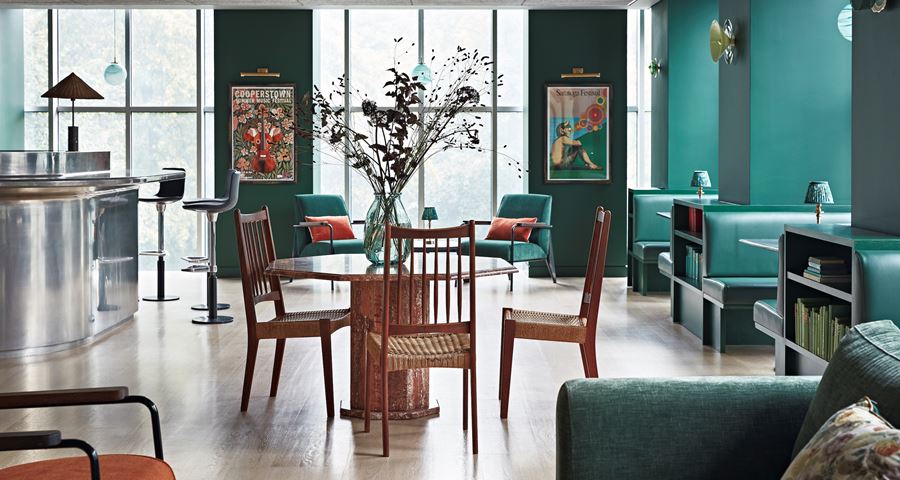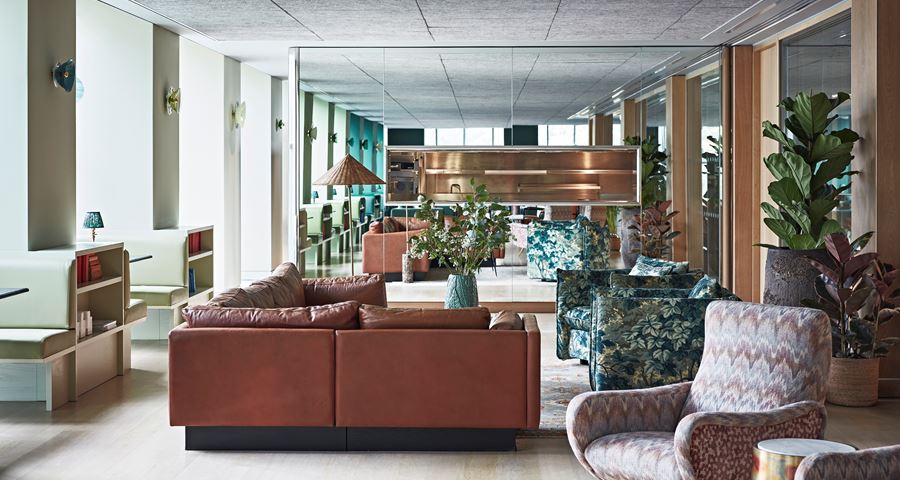Behind the scenes the Design Kitchen
Q&A with Matthew Williamson
This Q&A reveals interior designer Matthew Williamson's inspirations and thinking behind the Design Kitchen, our food & drink space located on the second floor.

Matthew Williamson © Photo by James Kelly
Matthew Williamson is an internationally renowned British designer, who early in his career was a recipient of the British Fashion Council’s NEWGEN award. He was the subject of an exhibition at the Design Museum in 2007 before establishing himself as an interior designer in the early 2010s.
Williamson has brought his warm style and use of vibrant colour and vintage pieces to create a new space for visitors to enjoy on the museum’s second floor. His design scheme for the room was inspired by the Design Kitchen’s stunning views of Holland Park.
Williamson has used a rich colour palette of green and terracotta to connect visitors to the outdoor surroundings of Holland Park, and the reupholstered booths in a palette of greens provide an ideal vantage point into the park. The space blends vintage furniture, bespoke pieces and mid-century design classics with some of his own contemporary lighting designs.
The launch of the Design Kitchen coincides with the publication of Williamson’s new book 'Living Bright: Fashioning Colourful Interiors', a practical guide to embracing bold colours in home interiors.

the Design Kitchen, courtesy of Jon Day and Matthew Williamson
Q: What inspired your vision for the Design Kitchen?
I chose to focus on the views out from the windows to Holland Park as my inspiration. A rich palette of varying tones of green was used to invigorate the space. During the project, I was mindful of respecting the building’s architectural essence but keen to reorder what goes in the space so that it would contrast and add warmth. Mid-century furniture, hand-blown glass lighting, velvet and printed upholstery were selected for a homely, informal atmosphere.
Q: What was the best part of this project?
I’m always excited at the start of any project and this one was no different. Trying to unlock the brief and deliver above and beyond what’s expected is always a challenge that I love. Having happy clients is the name of the game. I also really enjoyed working with a small, talented team. Together, I think we have elevated the space that we were given and repurposed it for everyone who visits the museum to enjoy.
Q: How would you describe the style of your design?
I’m known for and love bold colours, intricate patterns and perhaps a maximalist approach. With this project however, I was keen as I always am to reign in my person preferences when necessary and put first the needs of the client. The result is still striking but it’s also space which I feel is restrained, calm and peaceful.

Q: What motivated you to become an interior designer?
I chose to end my career in fashion in 2016 and pivot towards interior design. I was becoming less interested in the cyclical nature of fashion after 20 years and was drawn to the slightly slower pace of designing spaces. Both industries are so closely linked, and I feel like my years in fashion were the perfect training for my current career. I now spend my time designing two or three spaces a year, both commercial and domestic spaces as well as designing homeware products. It’s a nice mix and amount of work which suits me well now.
Q: In what ways do fashion and interior design overlap? And how did moving into interiors from fashion change your outlook as a designer?
The beginning of the process in both industries is strikingly similar. Moodboards, research, fabric sourcing. The main difference for me, which I like, is that I’m now dealing with real people. Interior design is or can be less reliant on the digital world. I used to make fashion collections for people who I never knew or met, but now I’m working directly with clients, and I enjoy that interaction and making something bespoke for them. I’ve also observed that working with interiors rather than fashion feels more permanent, less transient and perhaps more meaningful and useful too.

the Design Kitchen, courtesy of Jon Day and Matthew Williamson
Q: Who is one designer that inspires you and why?
There are so many, but a few heroes and heroines of mine are Dries van Noten, Julian Schnabel, Ossie Clarke and Zandra Rhodes.
Q: How has the world of design changed since you began your career? Do you see a wider shift happening in the culture of interior design with regards to sustainability?
I would say the biggest change is the transition to digital. I remember back in the day, waiting each month for Vogue Magazine to come out to see who was wearing what and was I in it! We are in a very different space now, largely due to technological advances and our phones which seem to have taken over our lives. Whist they can be invaluable and perhaps even crucial for anyone in business today, I’m definitely old school and favour pens, paper, paints and tear sheets any day. I love working in my studio on new projects without a phone or a computer to see what I can come up with. I think there are good strides being made now in the creative industries across the board with regards to sustainability. I, for one, have always favoured older pieces and natural materials when it comes to design. 90% of the pieces I sourced in the Design Kitchen at the Design Museum are vintage and sourced within the UK.

the Design Kitchen, courtesy of Jon Day and Matthew Williamson
Q: What is one piece of advice you would give yourself as a young designer? And what would you say to young people who would like to follow a career path in interior design?
My advice would be to try to find the confidence to believe in yourself and to create a vision with a unique selling point, if selling is in fact your goal. Today more than ever, you need to be able to sell what you do, talk about it confidently and promote it, so it’s essential to really own what you do.
I’d tell a young aspiring interior designer to first hone their craft, perhaps on friends and family, and then ideally work for someone you really admire to learn more skills and extract from the experience what could work for you. Learn what it is that sets you aside and makes your work special.
Plan your visit
Open daily
The Design Museum is the world's leading museum devoted to contemporary design in every form. Plan your visit today.